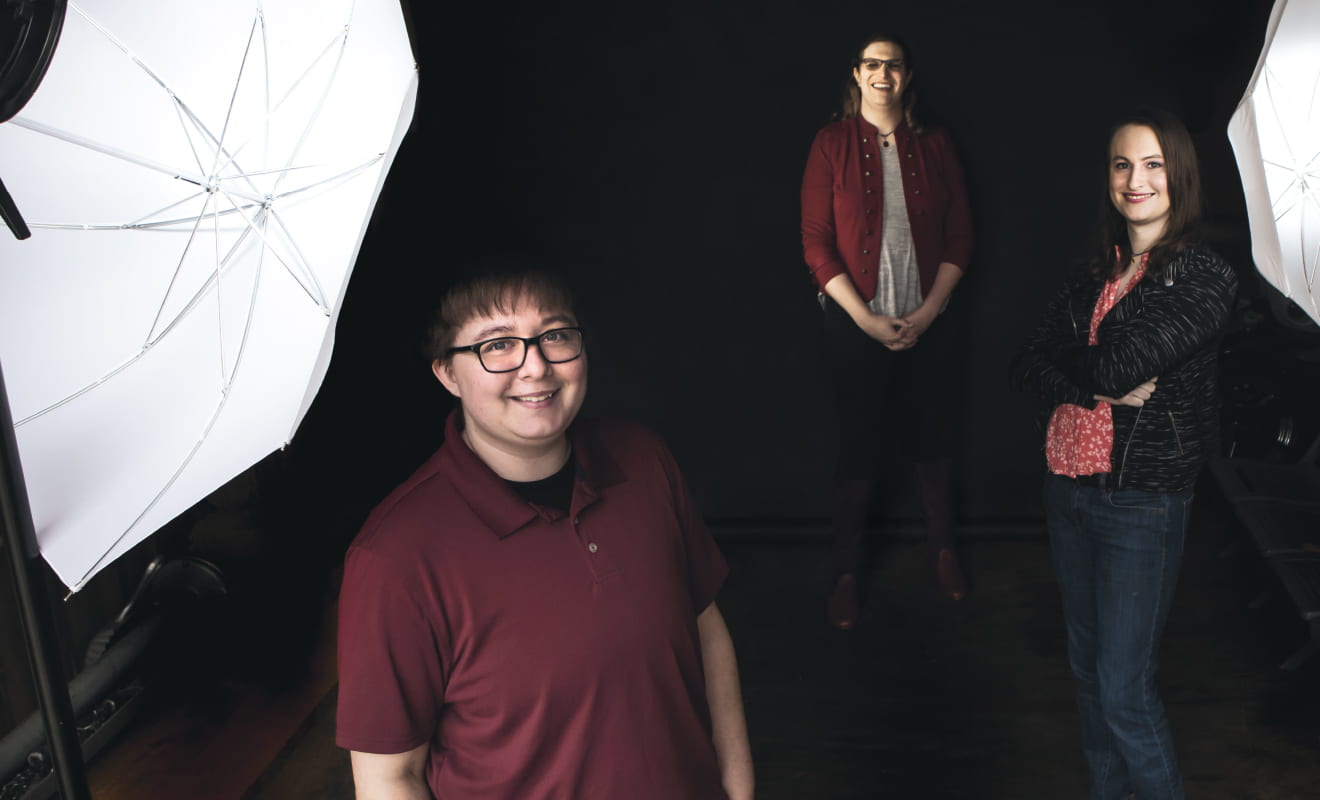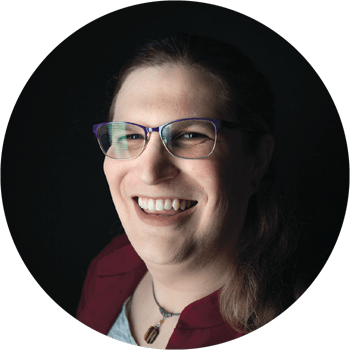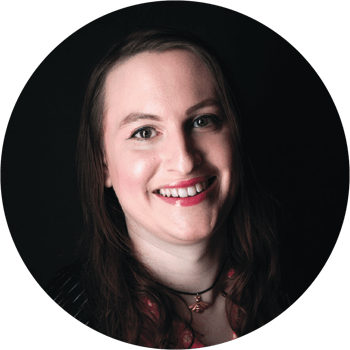Remember the first time you “saw yourself” in something? Whether it was in a piece of media, a career path, or even something as simple as a Wikipedia article, there’s a certain high that comes from representation and knowing you’re not alone in your identity or emotions—that someone gets it, gets you.
It’s an invaluable feeling, one that’s difficult to describe and impossible to replicate. The importance of representation in all areas of life has been advocated for—more than ever before—in everything from pop culture to professional arenas, so much so that it can be all too easy to overlook the environments (like STEM) that are still sorely lacking.
I knew I wanted to be an electrical engineer since second grade. My dad is one too, and he got me really interested in math and science.
JAMES IMPERIALI ’13
Janelle Drake ’11, Jolene Cotnoir ’10, both transgender women, and James Imperiali ’13, a transgender man, are taking steps to change that—by just being themselves.
The Wide World of Stem
For Imperiali, his passion for STEM started with a kids’ restaurant menu.
“I knew I wanted to be an electrical engineer since second grade,” he says. “My dad is one too, and he got me really interested in math and science. We’d go out to restaurants and he’d write out equations for me to solve on the coloring sheets,” he recalls with a laugh. “I loved it, it was so much fun.”
Over the years, Imperiali’s taken those crayon equations and transferred them to actual trains—he’s now an electrical engineer for CRRC MA, building new trains for the Red and Orange lines in Boston. He credits his time at WPI for helping him come into his own both professionally and personally, thanks in particular to project work and his involvement in Alpha Phi Omega (APO), WPI’s co-ed service fraternity, of which Drake and Cotnoir were also members. “Gradually, through my time at WPI, I learned and became more confident,” he says. “Before, I kept to myself; I was very quiet, shy, and anxious. It all definitely helped me grow into who I am today.”
Cotnoir, on the other hand, has kept things a bit closer to home as an instructional technology specialist in WPI’s Academic Technology Center. As the resident Zoom expert, she has had a busy year. (Chances are if you had any trouble with Zoom during COVID-19, she was the one who helped you out.)
Though her initial major was Computer Science, she switched to Interactive Media and Game Development after helping friends with their homework and really enjoying what they were working on. “I liked the idea of constantly having to learn about new tech and apply it to situations,” she says, adding that her interest in audio and instruments was a nice added touch and brought everything full circle. “It all came together and now I’m very much in my element.”
Like her peers, Drake, who works as a mechanical engineer at Setra Systems, always had an interest in STEM—albeit one that shifted over the years. She began with a passion for biology in middle school before being drawn to machining and manufacturing in high school. During a visit to WPI to explore the new CNC lab, some well-timed advice from her machine shop teacher prompted her to consider mechanical engineering, and the rest is history.
“I almost fell into it, in a way,” she recalls. “But it was a combination of everything I’d been doing and enjoying.” Now Drake’s career has her working with electrical and software engineers to develop fully functioning mechanical products, such as equipment for measuring weight, temperature, humidity, and air pressure. She’s currently working on a project to help schools and businesses provide clean isolation rooms in a continued effort to mitigate the effects of COVID-19.
Cotnoir and Drake were also in the Pep Band together, regularly treating the WPI community to the sounds of the mellophone and alto sax, respectively. They also had a chance to reconnect at an Alumni Association event just a few days before Cotnoir had been planning to come out at work.
“I hadn’t seen [Janelle] for a while and I knew she was queer, but I didn’t know she was trans. I was thrilled to death [to see her], but the timing was absolutely ridiculous,” she says with a laugh.
A Personal Story
Drake, Cotnoir, and Imperiali all began exploring concepts of gender more deeply in college (Cotnoir even wrote a paper on sexuality for her Humanities and Arts Requirement), but didn’t come out until years later. While each story is different, all resonate with a feeling of needing to, and being relieved to, live in a way that feels most like themselves.
“I didn’t know anyone else who was going through what I was, so it was hard for me to place those feelings in a way that made sense,” Cotnoir says. “But as time went on and I saw younger folks exploring their gender much more freely, it was like a big eye-opener for me.”
Imperiali knew he was trans, but didn’t realize he needed to medically transition until this year. “I thought I could just live my life as it was and just get through it, but I decided that no, I can’t. Why was I doing that to myself? I decided to just go for it,” he says. After coming out to his parents in early April, he began hormone treatments and hasn’t looked back since.
I started identifying as a cross-dresser my junior and senior year, then more as gender-fluid a couple years after college.
JANELLE DRAKE ’11
Drake began playing with gender expression briefly at the age of 10 of 12, but didn’t really start exploring terms and identities until she got to college, where she began putting different terms to what she was feeling. “I started identifying as a cross-dresser my junior and senior year, then more as gender-fluid a couple years after college.” What really drove things home for her, though, was playing the role of Santa Claus at a holiday party at work for employees’ children in 2017.
“That night as I was getting dressed for the role, I realized all of a sudden, ‘Oh my god, I really don’t want to grow up to be an old man. It’s not who I am,’” she explains. The situation was made more difficult by the fact that she had already come out to her family as gender-fluid, and didn’t want to come out again as trans during the holidays. Instead, she kept it to herself for the rest of the year before exploring her options more deeply in the new year.
Finding Footing and Moving Forward
There’s no question that Drake, Cotnoir, and Imperiali are good at what they do professionally. But merging a professional life with the deeply personal process of coming out can be challenging. In the best of circumstances, the process can be mentally and emotionally exhausting to the highest degree, but doing so in a field that’s inherently biased against you? It’s got the potential to make it all ten times worse.
However, Imperiali, who left a past job due to rampant sexism in the workplace, wasn’t going to let said biases get in the way of the passion that he’d had since the second grade.
“Sure, I was kind of nervous, especially because the industry I work in is even more traditional than usual—it’s a bit of a good old boys club,” he says. “But my reasoning was, ‘What’s transitioning going to do? People already treated me differently before, it’s just more of the same, just a different flavor.’”
As it turns out, Imperiali had no need to worry—since coming out publicly in June of this year, he’s experienced nothing but support from friends, family, and his employer.
Drake also considers herself lucky to have been in a friendly work environment when she began seeking assistance for socially transitioning at work. She had been working for her previous company for four and a half years when she started to come out to her bosses and the human resources department, then eventually her colleagues.
There’s no such thing as a life without curveballs, though, and Drake was handed one at a pretty inopportune time, having her first day at work as herself after months of preparations before receiving unexpected news shortly thereafter. “They were going through financial trouble, so unfortunately two weeks after I came out, I got laid off,” she says. “That put me headfirst into the job market as trans with only two weeks of experience working as trans.”
As Drake’s job search progressed over the summer, she found herself trying to anticipate how people would interpret her resume (which still noted her as reaching Eagle Scout) or how people would accept her. “I didn’t know how people would react to me,” she says. But she also knew she wanted to be open so that she would find a workplace that valued her. “My LinkedIn profile says that I’m trans,” she adds. “I just wanted to be open with people in case that was a problem; then I could screen [employers] out more quickly as a place I didn’t want to work.”
Her approach mirrored what she took from her WPI education as well. “The best way to frame a problem starts up front,” she says. “How you frame the problem up front can help solve a lot of things more creatively as you go deeper into projects.”
While support was abundant for Drake, Cotnoir, and Imperiali, and career issues were averted, there are other issues that, frankly, most are privileged enough to not have to even have to think about. For example, if a cisgender person who wears makeup decides to forego it for a day, someone may comment that they look tired. Not ideal, sure, but also not the end of the world. But if Cotnoir decides not to wear makeup, she explains that there’s a risk people may not see her as a woman.
“Some days I really wish I could just roll out of bed and go to work, but I have to think, especially now when I’m going to be on camera, how will I look?” she says. “It’s not that I’ll look sloppy, it’s that people might regard me as male, and I really don’t want that. Even people who know me, they’ll slip up more, so I feel like I have to, to some degree.”
Cotnoir was also faced with a task that seems simple, but ended up being Herculean: getting her name changed in Outlook.
I realized I wasn’t being a very good role model if I was stuck in the closet, you know?
JOLENE COTNOIR ’10
“A lot of our systems aren’t entirely coded to handle transitions, name changes, things like that,” she explains, adding that the issue isn’t even just for queer people; it also applies to those who change their name after marriage and other similar scenarios. “It took a lot of back and forth to get Outlook to stop changing my name back to my old name. Eventually they had to rework how some of the things pull in information.”
While the experience was more frustrating than anything else (“I had people messaging me … calling me two different names in email chains. Students would come to the office and not know who to look for …”). Systems have been amended, and Cotnoir says she was able to find some entertainment when folks didn’t recognize her, giving her the chance to reintroduce herself.
“Some people commented, ‘what happened to that nice boy who used to work here?’ Those were my favorites because they legitimately didn’t recognize me, they thought I was somebody new.” She pauses, then adds with a laugh, “I should’ve said, ‘I don’t know, was he cute?’”
Life After Coming Out
Remember how Drake, Cotnoir, and Imperiali were all members of APO? That desire to help and support others—especially queer students and peers in STEM—is still going strong, whether that’s through pride flags on display in offices, mentoring groups of local LGBTQ+ teens, or advocating for fellow trans coworkers who may not have the same resources when it comes to insurance and coverage.
“I’m definitely using my trans identity to advocate for others when I can now,” Drake says.
Imperiali’s got a similar outlook. “I really like helping people,” he says simply. “If my story, my life, what I do, helps someone, that’s great, and I’m glad that I can. It’s cool.”
Growing up and figuring out her identity, Cotnoir didn’t really see a future, she didn’t have a plan. Now that she does, it’s something she wants to share.
“I realized I wasn’t being a very good role model if I was stuck in the closet, you know?” she says. “Whether or not I’m role model material, I don’t really care, but the important thing I want people to know is that, hey, I’m queer. I have a full-time job, I’m doing something I enjoy, and I’m doing it well. I’m happy.
“There’s something to be said for seeing somebody like you who’s made it to a place that you want to get to. It’s … it’s good.”
Seeing “somebody like you” who has achieved a sense of accomplishment, of belonging, and maybe, finally, feels an authentic sense of self is inspiring, but when that ‘somebody’ is the face you see in the mirror, it’s even better.”
Queer Support at WPI
WPI’S DIVERSITY & INCLUSION TEAM is focused on creating an environment that’s not only welcoming and where acceptance and respect are expected, but most important, where people can be their most authentic selves. They do it all through open dialogue, education, and learning from the lived experiences of all.
“We care deeply about developing educational opportunities for our students, staff, and faculty that
promote identity development and a deeper level of cultural proficiency,” says Rame Hanna, director of
Diversity and Inclusive Excellence. They go on to add that diversity, equity, and inclusion (DEI) programs are “developed with an intersectional lens to promote greater representation and meet each community
member where they are at in their lifelong journey to self-awareness.”
Their efforts, as well as those of the entire DEI team, aren’t going unnoticed. “Those are huge,” Jolene Cotnoir says. Whether it’s outreach during the COVID-19 pandemic, virtual or in-person events when they were possible on campus, or the general sense of welcome from DEI, Cotnoir says this kind of getting in touch makes an impact and is an invaluable step toward continued community building and change.
“More is great,” she says. “Anything to elevate queer voices is absolutely fantastic. Uplifting queer voices,
voices of color, voices of the differently abled … the first step is usually sharing those experiences. Once
you hear about what somebody has to go through, you start to sympathize with them, and you start to think, ‘OK, what can I do?’” As more people are encouraged—and have a safe space—to share experiences, the script changes, says Cotnoir. “Everyone has a chance to tell their story and everyone can actually change something.”






